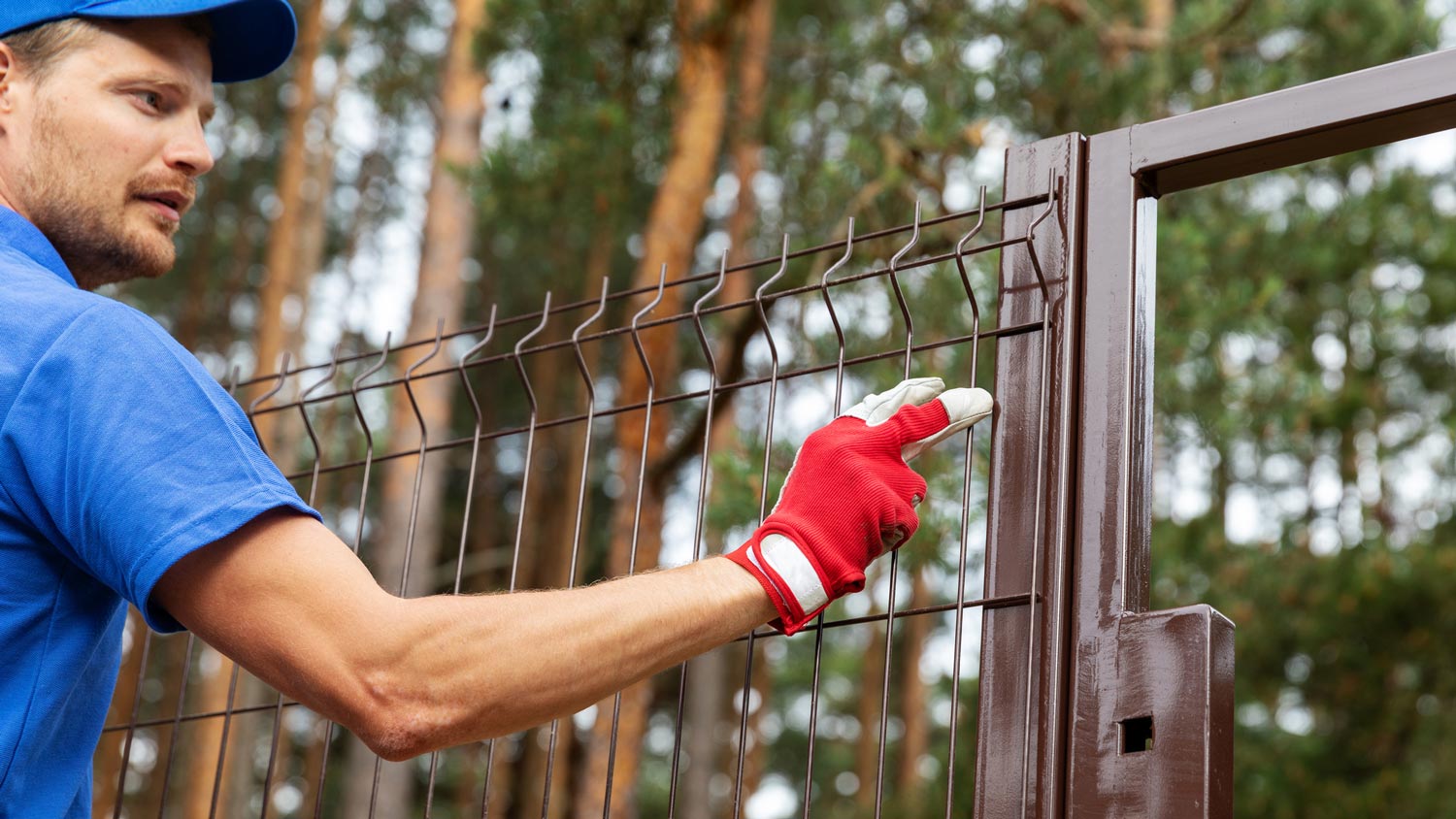
Whether you have bugs, bats, or rodents invading your home, you’ll want to contact an exterminator quickly. Find out how much pest control costs in Columbus, OH.
Make sure these opportunistic predators don’t get too close


Wildlife removal costs between $191 and $613, but hiring a pro will ensure you and your family are safe and sound.
You can use scare tactics, but it’s never wise to get too close to wild animals.
DIY deterrents may not keep coyotes away permanently.
Pros have repellents that won’t harm the pets or people in your household.
To avoid having coyotes return, hire a local wildlife control pro.
It can be an unnerving sight for any homeowner to see a wild coyote walking through the yard, especially if you have a plucky Pomeranian or a brazen kitty. But don’t panic: These savvy creatures usually try to avoid human contact and very rarely attack people. Thankfully, as this guide shows, learning how to keep coyotes away from your home doesn’t mean you have to resort to drastic deeds. Next time you spot a coyote near your house, try these scare tactics and methods for preventing them from returning.
Sightings of street-smart and adaptable coyotes are widespread in many parts of the country, and they won’t only try their luck around rural retreats—it’s not uncommon to see them slinking around city neighborhoods.
If you’re canny around coyotes, they’re unlikely to pose a threat—human attacks are rare and often avoidable. But there’s no getting away from the fact that, given the opportunity, small dogs and especially cats make fine meals for these opportunistic predators. That’s why it’s essential to protect your pets from wild animals like coyotes that may pose a threat. Plus, if your yard is a treasure trove of treats for them, regular returns can result in bin raids, smelly scat deposits, and holes in your lush lawn.
Not just the howling or after-dark sightings mean coyotes might be congregating around your patch. Look out for the following signs:
Scat (often rope-like and containing hair and bones)
Tracks (similar to dogs, but typically going in straight lines rather than winding)
Raided trash bins
Remains of dead prey
Changes in behavior in your pets because of coyote scent

Hazing is always a good first step when you encounter a coyote. Ideally, using scare tactics will restore a habituated coyote's natural aversion towards humans, so they aren’t so likely to return to your yard. If the coyote is acting strangely or unusually aggressive, however, back off and call animal control.
In some cases, your presence will be enough to ward off a rogue coyote. Make yourself look big and move toward the coyote while waving your arms and yelling. Don’t get too close to the animal, and transition quickly to another tactic if it doesn’t scare them away.
You can easily spook most coyotes by making loud, sudden noises. Try tooting an air horn or banging pots and pans together to make sounds loud enough to scare them away. Even shaking a can filled with pebbles or coins or flapping a large trash bag should work. Keep in mind that these tactics may disturb nearby neighbors if performed late at night.
Another scare tactic is to spray water from a garden hose in their direction or to throw sticks or small rocks near them. Be sure not to throw or spray directly at the animal to prevent injuring or angering it.
Coyotes are primarily nocturnal predators, so they prefer to operate under the cover of darkness. To spook them away from your trash bins, turn on your floodlights or other outdoor lighting.
If coyotes regularly patrol your neighborhood, it might be worth installing motion lights or sprinklers. Coyotes are less likely to enter your yard if they get a fright when an unexpected spray of water or a flash of light hits them.
Coyote-proof fencing needs to be at least 8 feet tall and made from material coyotes can’t climb, or 6 feet tall and fitted with coyote rollers. These additions make it tough for the coyotes to scramble over.
Coyotes are prolific diggers, so the fence needs to go at least 1.5 feet deep into the ground. Also, consider trees near your fence installation. Coyotes have the skills to climb trees and could use them to scale a nearby fence. The cost to install a fence runs between $1,500 and $8,000.
Liquid or granular repellents won't be a miracle fix—like many homemade remedies to ward off wildlife, they don’t have scientific backing, and you’ll need to reapply them a lot (especially after rain). However, they are relatively inexpensive and could be worth a try if you use them alongside other deterrents. Some DIY options to try around your yard perimeter include:
Open jars of vinegar
Rags soaked in a mix of mouthwash and mint extract oil
Rags soaked in ammonia, but not around pets or kids
Even after you’ve scared off any visiting coyotes, if your yard is an enticing place for them, they may pay you another visit. Getting rid of temptations (and encouraging your neighbors to do the same) and introducing deterrents are sensible parts of the strategy.
Feed pets indoors or remove any food bowls (and clean up the crumbs) right after your pet finishes their chow.
Contain trash and compost in secure, enclosed bins.
Clean up any fallen bird seed around feeders.
Don’t delay in tidying up fallen fruit.
Don’t leave pets outside without supervision, especially after dusk.
Keep your cat indoors to guarantee their safety.
Walk your dog (regardless of size) on a leash no longer than 6 feet long—even big dogs can get into scraps with coyotes over territory.
Keep chickens or rabbits in secure enclosures with strong mesh covers that go at least one foot into the ground.
Remove sources of standing water, especially during hot weather.
Scare tactics and DIY deterrents are ways you can easily ward off coyotes on your own. However, if the coyotes are getting overly brave or a major nuisance, it pays to take advice from a wildlife removal expert near you. If you have concerns about unusual or aggressive coyote behavior, report it to the local animal control or police department. Alternatively, in some states, you may be able to hire a licensed trapper directly. The average cost for professional animal removal is $350.
Gemma Johnstone contributed to this piece.
This company does it right. Firstly, I want to say that Landan was a joy to work with. He was so kind, transparent, and had everything under control. His entire team showed up ready to work and they were all very respectful of the fact that we were in an office space. A little backstory – we...
Our office has a new lease on life, thanks to Custom Paint Jobs LLC. Outstanding work!
Window Depot did an amazing job on my deck. I wasnt sure what I wanted to do, but their composite decking was affordable and will last a long time. I am excited to have family over, and I am no longer embarrassed by my backyard. Jeff and the ground crew were polite, respectful, and caring for...
Storms Mobile Welding was great to work with. They were prompt, professional and did an overall excellent job on the project. I highly recommend.
AFS was excellent from start to finish. Jess, the sales associate, was fantastic...very knowledgeable and very professional. The installation crew was excellent. I couldn't be more pleased with the process. Best of all, my new floor looks fantastic!
We used Unique Hardwood Floor LLC three years ago to work on the floors of a 70 year old home that needed a great deal of work. Some floors needed repairs, some were replaced and others just needed to be refinished. It was a complicated job as they needed to blend the old and the new to...
While Naaman and Mike were very professional and amicable to work with, there were issues in this project that makes giving a higher rating impossible. We had several communications issues that delayed completion. The roofers accessed the property without communicating with me. Just showed up...
Mr. Pooner's company came out gave us an estimate and promised installation within 10 weeks from receipt of signed contract and deposit. Mr. Pooner obtained all the necessary licenses and began work promptly. His company's workmanship is excellent. The garage door is mounted on steel...
My 2nd floor furnace was only working sporadically and the warranty company sent Air Fast to fix the issue. They came out and shut off the furnace completely. Said they would be back the next day when they had a new flame sensor... 4 more days passed with me calling them multiple times a day...
They called 15 minutes before arrival to announce that they were coming and arrived on time. Immediately they saw the broken springs and replaced them very quickly. Jeff suggest that I put on a rope to the manual switch to operate it more easily if necessary. I explained that my old door...
From average costs to expert advice, get all the answers you need to get your job done.

Whether you have bugs, bats, or rodents invading your home, you’ll want to contact an exterminator quickly. Find out how much pest control costs in Columbus, OH.

Find out how much it costs to remove armadillos and stop them from coming back. Know how much to budget to humanely remove these pesky critters from your yard.

When calculating the cost of hiring a flea exterminator, consider your home size and the infestation extent. This guide will help you figure out what to budget.

While ground bees play an important role in our environment, severe infestations can cause issues. Learn how you can get rid of ground bees with this guide.

Think you might have a cockroach problem? Learn how to get rid of roaches and spot common signs of infestation in this guide.

There are many types of mites that may infest your home. Learn how to get rid of mites and tips for preventing them from returning.